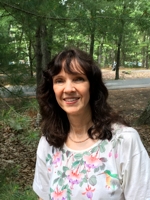Poems by Lucille Lang Day
Archives: by Issue | by Author Name

Avon Calling in the Amazon
by Lucille Lang Day
From Canary Summer 2010
Lucy lives in the San Francisco Bay Delta Watershed, which covers more than 75,000 square miles. Her particular corner of this vast watershed is the watershed of Pleasant Valley Creek, which unfortunately now runs mostly under Grand Avenue in Oakland.

When the fog lifts, the river is full of tiny eyes
scanning the surface like submarine periscopes:
four-eyed fish seek floating insects.
Close-packed trees along the bank
silently compete for light. Lianas thick as wrists
run from canopy to ground and back again,
creeping everywhere, weaving the forest together.
Moths the size of human faces swoop in shadows,
but no howler monkeys call from tree to tree:
stillness permeates midday heat, except
for the put, put, put of the Avon lady's boat
with its cargo of Single Stroke
One Coat Nail Enamel, Pearls & Lace
Cologne Spray, Casbah Bath & Shower Gelée.
She has eaten so many Hershey bars
her two front teeth have decayed and fallen out.
She has washed her braids today
with Avon Plus Shampoo and splashed
bubble bath in the river. Her clients will give
chickens in exchange for SeaZone, the exhilarating
new fragrance with the power of the waves.
From Infinities (Cedar Hill), by Lucille Lang Day. First published in Blue Violin.
© Lucille Lang Day
Last Day of Zoo Camp
by Lucille Lang Day
From Canary Summer 2016

Children, in blue-and-gold
Zoo Camp tee shirts, gather
at picnic tables on a hilltop
shaded by pines. They have met
the boa with its reddish brown
camouflage pattern; baboons
with butts callused for comfort;
fruit bats, which cannot
echolocate but see better
than any other bat; sun bears
with orange necklaces of fur;
and turtles, whose favorite
color is red. The little train
has taken the campers past
wallabies, emus and kangaroos,
which cannot walk backward.
They have hidden treats
for chimpanzees, whose DNA
is ninety-eight point four
percent identical to their own,
and watched them eat, eager
as children finding candy.
Now the campers sing about
penguins, which can stay
underwater for twenty minutes;
hippos with four-foot-tall smiles;
and tigers with striped skin
beneath their striped fur.
Parents and grandparents
look on—remarkable mammals
with twenty-six bones in each
foot, a nose that can remember
fifty thousand scents, a brain
that’s eighty percent water,
and a charge to save this planet
where they are outweighed
by termites, ten to one.
© Lucille Lang Day
What the Tortoises Know
Galápagos Islands
by Lucille Lang Day
From Canary Spring 2019

On Genovesa, as my husband lay
on the beach of Darwin Bay,
a sea lion came to sniff his toes
and a red-footed booby, sitting
with her chick in a mangrove
nearby, let me get kissing-close.
On North Seymour, the frigate birds
weren’t phased by me, and a young
blue-footed booby was intrigued
by my walking stick. On Española,
the sand was so thick with iguanas,
it was hard not to step on them.
The guide explained that the animals
here don’t fear us, hawks and short-
eared owls being the only predators
evolution has bred them to know.
They first saw humans with guns
and bows just five hundred years ago.
But giant tortoises, who live to be one
hundred fifty years old, have seen
how we kill to make boxes and combs,
so heads and legs withdraw into shells
at the sound of a loud voice and
they grow still as clean-picked bones.
© Lucille Lang Day
Where the Radiation Goes
by Lucille Lang Day

When an earthquake cracks
a reactor, iodine molecules
ascend. Tumbling in hot wind,
they drift to a grassy slope
where mottled cows graze.
Soon children will drink milk
that scintillates like a galaxy.
A woman opens an umbrella,
as broccoli, lettuce, mustard
and spinach are suddenly
bathed in strontium rain.
There’s nowhere to go except
earth, sky, and sea—algae,
fish, clouds, birds, trees.
Radiation from a test in China
ends up in Utah and Colorado.
Fifteen years after Chernobyl,
the isotopes were still found
in stalks and delicate gills
of wild mushrooms gathered
by picnickers in France.
© Lucille Lang Day